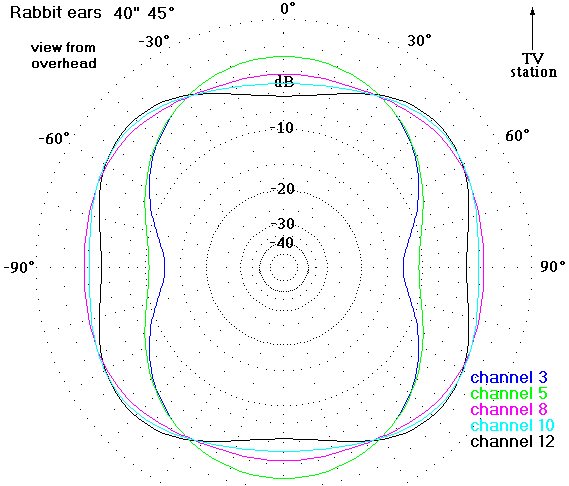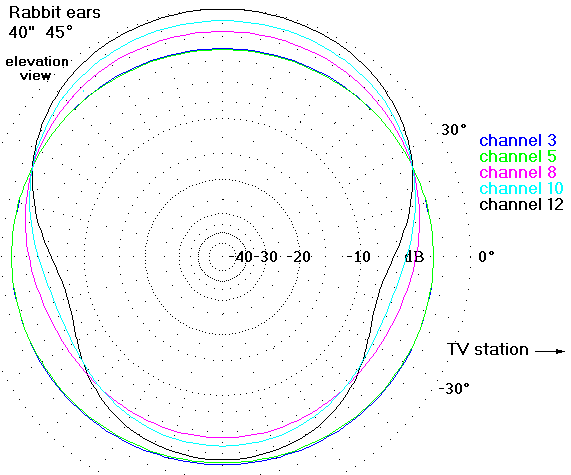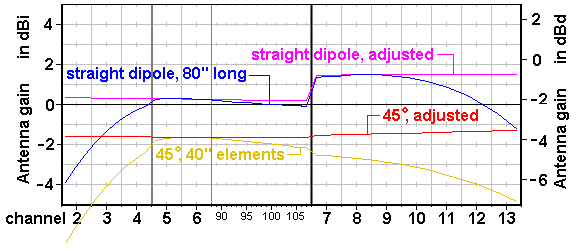6/9/15


The above
diagrams are for a “V” shaped dipole (rabbit ears) 40 inches long (80 inches
total), adjusted to 45°,
and connected directly to 300W
ribbon cable without any balun or adapter. If this is all you need, great! Rabbit ears often come with amplifiers or
switched “tuning circuits”, and a UHF loop is common. Ribbon cable loss is easier to avoid for VHF
than for UHF. For VHF, ribbon cable
should not be up against anything metal.
Units with
amplifiers
In most cases
all the amplifier does is allow the maker to claim a high gain number. As was explained in the section “Antenna
Basics”, the amplifier will compensate for loss in the cable but will not
improve the antenna. The loss in the
four feet of cable that comes with the antenna is probably not significant. The true gain for rabbit ears is what is
shown in the net gain graph, not what the maker claims.
Most
receivers have a VHF noise figure somewhere in the range 4-10 dB, with 6 dB
being typical. If the antenna amplifier
has a noise figure below 4 dB then you can assume it is probably quieter than
the receiver. In this case, the
difference between these two numbers represents an improvement provided by the
amplifier, and the amplifier is a good idea.
But few indoor amplifiers are that good.
If the noise figure is not listed on the packaging then you can assume
the amplifier is not quiet enough to be an
improvement over the receiver.
It may be
reasonable to buy an amplified indoor antenna if :
- the amplifier has a VHF noise
figure below 4 dB.
- you need a longer cable to reach
a good reception spot.
- you want to feed two sets using a
splitter.
- your TV has 300W VHF terminals. The amplifier can overcome high ribbon
cable loss where the rules can’t be followed.
Units with tuners
Many indoor
antennas have a rotary switch on them that you must set each time you change
channels. This switch improves the match
between the antenna and the feedline. When effective, it makes the net gain as good
as the raw gain. But it is not generally
obvious how well it will work. (There is
no way to tell before you buy.) You may
find you can tune it to your weakest station and forget about it.
Getting
the most out of rabbit ears.
If your
rabbit ears do not have a tuning switch, you can achieve some tuning by
adjusting the length of the elements.
The following lengths are for rabbit ears set to 45° and connected directly to a 300W ribbon cable, no amplifier. These are total lengths measured with the
elements horizontal. Keep both elements
equal in length. If the elements have
metal (not plastic) “eye protectors” on the ends, subtract an inch or two from
the following lengths.
2 3 4 5 6 7 8 9 10 11 12 13
113” 103” 94” 83” 78” 44” 44” 43.5” 43” 42” 41.5” 41”
Additional
gain is achieved by making the elements horizontal, making the antenna a
straight dipole. Assuming your living room
has space for this and that you can keep the antenna far away from anything
metal, the following lengths (subtract an inch or two for metal eye protectors)
should be used.
2 3 4 5 6 7 8 9 10 11 12 13
109” 99” 91” 80” 74.5” 84” 81” 78” 75” 72” 69.5” 67”
The straight
dipole has nulls to the sides that can eliminate interference.

(Some people have
commented that these lengths are too long for channels 7-13. They are not. Maximum
gain for a straight dipole occurs at a length of 1.28 wavelengths, a
configuration often called an Extended Double Zepp. The name comes from the half-wavelength
end-fed wires that were dangled from Zeppelins
As the graph shows, the gain is about 3 dB above that of a half wave
dipole. I used EZNEC to optimize the
lengths, thus compensating for the cable mismatch. Different numbers would have resulted if a balun were included, but I
think cheap rabbit ears are usually supplied without any balun. If your rabbit ears have a balun, the lengths will be wrong. Note that the dipole must be straight. The advantage of the Extended Double Zepp disappears in the Vee
configuration. Also the Extended Double Zepp is more directional than the half wave dipole. It must be aimed more carefully.)
If for
channels 2, 3, and 4 you cannot achieve the lengths recommended above then
connecting large metal balls to the ends of the elements will cause a big
improvement. These are called
“capacitive hats” and will match the antenna as if it is much larger. Balls an inch or more in diameter can be made
of loosely crumpled up aluminum foil.
Make both balls the same size, then experiment to find the best antenna
length.
This page is part of “An HDTV Primer”, which
starts at www.hdtvprimer.com